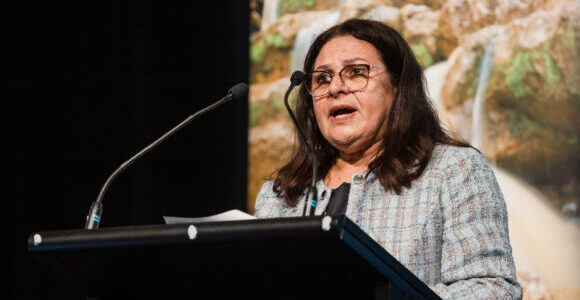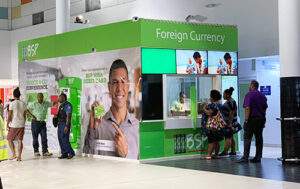Papua New Guinea’s banks and businesses tell Business Advantage PNG of considerable variation in wait times for foreign exchange, as the country’s central bank acknowledges the economic damage caused. We look at the prospects for improvement.

The Bank of Papua New Guinea’s Elizabeth Genia. Credit: Australia PNG Business Council.
Some businesses in Papua New Guinea are still waiting up to three months for their foreign exchange orders to be filled due to increased demand, despite ongoing interventions in the forex market by the country’s central bank, the Bank of Papua New Guinea (BPNG).
But waiting times are by no means the same for every business, with the size, sector and nature of businesses determining how quickly they receive foreign exchange.
At PNG’s largest bank, BSP, average waiting times on forex orders currently vary from one week for customers in critical sectors such as aviation, infrastructure, telecommunications and fuel to eight weeks for large retail businesses, according to Rohan George, Group General Manager – Treasury & Markets.
Similarly, Nathan Wingti, Executive General Manager – Treasury & Financial Markets at Kina Bank, tells Business Advantage PNG that typical turn-around times currently range from two-to-three weeks for small orders to eight-to-12 weeks for orders exceeding K500,000.
There appears to be no reduction in demand for forex, with Rohan George noting market volumes are up 4 per cent in the first four months of 2024, compared with the same period last year.
Businesses reveal impact
The ongoing impact on business is particularly felt by those that rely on international supply chain partners.
David Cusick, General Manager – Sales & Operations of Rhodes PNG, a major provider of prefabricated buildings and materials, says his company is currently waiting up to 11 weeks to fulfill its regular forex orders. However, he notes larger-than-usual orders see additional delays, which can result in missed business opportunities.
“We’re in a growth phase of our business at the moment,” he tells Business Advantage PNG. “We can draw upon the stocks [of homes] we’ve currently got in country, but trying to replenish those to meet [higher] demand can be a little bit trickier.”
“We were wrong to maintain an overvalued exchange rate when it was clearly not sustainable”
Nihal Shah, Chairman of Pacific Foam, a leading mattress and furniture manufacturer, says his company is currently being advised of eight-to nine-week waiting times for forex orders.
He tells Business Advantage PNG that the lack of forex availability means his company is unable to purchase the stock it needs to meet demand, costing it the equivalent of an additional 20 to 25 per cent in turnover.
Handbrake on growth
The negative impact on business was last week acknowledged by BPNG Governor, Elizabeth Genia.
“Foreign currency shortages have been a persistent handbrake on growth, leading to lower investment, reduced competition in key sectors and ultimately higher prices,” she told the Australia-Papua New Guinea Business Forum on Australia’s Gold Coast.
“We were wrong to maintain an overvalued exchange rate when it was clearly not sustainable, and we did not have the reserves to support the kina at an artificially high level,” she said.
Citing the International Monetary Fund, she said the PNG economy would have been US$3 billion – or 10 per cent – larger today if not for the bank’s previous policy of propping up the kina.
Genia, who served one year as acting governor before her permanent appointment in January 2024, said reforms introduced by the BPNG in the first half of 2023 aimed to correct previous errors.
This was a reference to the bank’s intention to see the kina depreciate gradually by increasing the flow of foreign exchange to the market.
“To end the rationing of foreign currency, the kina needs to adjust to its equilibrium level where the sensitivity of foreign currency inflows to the lower exchange rate can be tested,” Genia said.
“And this is what we are doing – cautiously, with full transparency, and without the excessive volatility associated with moving immediately to a floating exchange rate.”
According to BSP’s George, forex interventions by the central bank stood at K1.6 billion (US$420 million) year-to-date to April 2024, up 17% from the previous year. He estimates a US$150 million to US$175 million “mismatch” between forex supply and demand, “which will see outstanding forex orders grow until forex intervention and/or forex inflows from exporters increase.”
“So, this year looks very much like more of the same, when compared with 2023.”
Large forex inflows pushed out to 2026
Ultimately, PNG’s forex shortages may only be fixed by the commencement of new major projects, such as TotalEnergies’ Papua LNG and the Wafi-Golpu copper-gold mine.
In ANZ Research’s Pacific FX Insight, published this month, ANZ’s economists warn that delays to these resources projects would push back the timeline for significant new foreign currency inflows.
“Meaningful new foreign currency flows associated with mega projects in Papua New Guinea are not expected to arrive until 2026,” write ANZ’s Kishti Sen and Tom Kenny.
“Hence, we expect the kina depreciation will continue into 2025 and reach a bottom sometime in 2026.”
However, Elizabeth Genia has suggested a more immediate solution.
In her speech, she said the forex shortages had been exacerbated by the fact that large quantities of export proceeds were not being repatriated to Papua New Guinea.
Foreign currency inflows reached only US$5.6 billion in 2023, compared to total export receipts of around US$14 billion, she said.
“Had even half of that US$14 billion been brought onshore, we would be in a far stronger position this year.”
PNG’s forex shortages at a glance
BSP’s foreign exchange outlet at Port Moresby International Airport. Credit: BAI
Foreign exchange has ranked as the number-one concern of business leaders in the last two editions of the annual Business Advantage PNG/Westpac PNG 100 CEO Survey, and as one of the top concerns in every survey since 2014.
The kina soared at the peak of the construction phase of the giant ExxonMobil-led PNG LNG project in 2011-12 but fell sharply in 2013-14 as construction ended and commodity prices fell.
The Bank of Papua New Guinea (BPNG) reacted with the implementation of a trading band which immediately increased the kina’s exchange rate with the US dollar by 16%. It also introduced a policy of rationing foreign exchange to ensure the kina depreciated slowly, thereby aiming to avoid runaway inflation.
In 2023, the International Monetary Fund (IMF) approved PNG’s request for a US$918 million credit facility to support reforms to alleviate forex shortages. These reforms include a crawl-like exchange rate arrangement, supported by a “prudent but active foreign exchange intervention strategy” in the IMF’s words, to allow the kina to depreciate gradually and without creating volatility.









Speak Your Mind